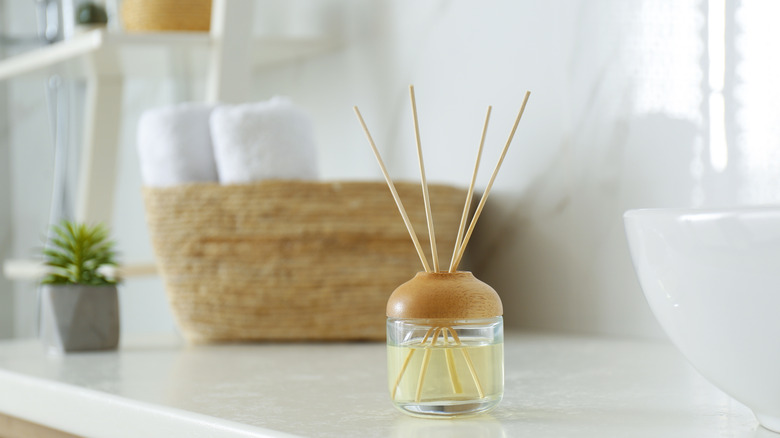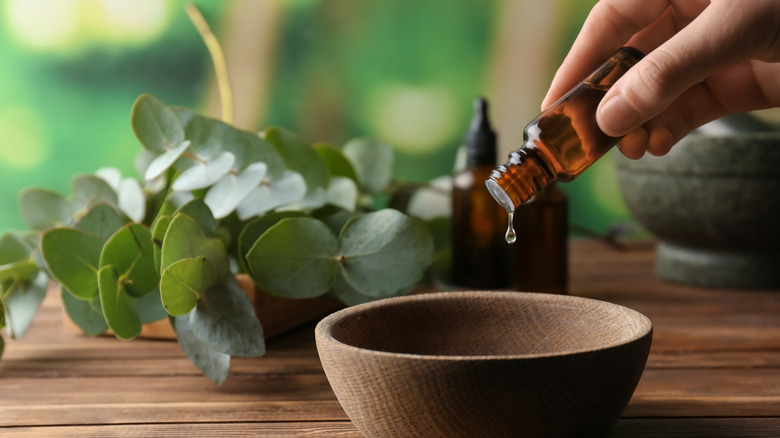Making Your Own Reed Diffuser Is Easier Than You Think
We may receive a commission on purchases made from links.
Your home is your sanctuary. It's a place of comfort, somewhere to find solace in and hide away from the world. It can also smell less than fresh on occasion. While you're likely used to the usual scent of your house or apartment, your living space may have an order to it that is easily perceived by others. This is called being nose blind, and it occurs when there is a consistent smell in a space that never goes away, causing our nose receptors to get used to it and stop paying attention to the scent, per Well+Good.
Although bad odors can go away with the lighting of scented candles and the spritz of an air freshener, why not try a slightly more permanent solution? Reed diffusers emit a constant scent in whatever space they're in, keeping a room smelling pleasant without the fire hazard of a candle or the potential asthma attack that an air freshener may bring on (via Oxyfresh).
There are so many reed diffusers on the market, but they can either be out of your price range or not have the exact scent you want. Why not tailor one to meet your exact needs?
How to make a reed diffuser
A reed diffuser is only comprised of three things: a glass container, essential oils and a carrier oil, and the reeds. The glass bottle should have a wide body and a narrow top, like this one on Amazon, so that it doesn't spill out easily if knocked over. It's important to go with glass as essential oils can deteriorate plastic, according to Soap Queen.
For the oil blend, you'll need your choice of essential oils along with a carrier oil, such as almond or jojoba oil, to help dampen the intensity of the essential oils, Essential Oil Haven advises. Pour half a cup of the carrier oil into the container and add about 30 drops of your essential oils. If you want the oils to evaporate a little quicker, Apartment Therapy recommends adding a little vodka.
Next comes your reeds. Bamboo and fiber reeds are used in diffusers, but Rolling Stone prefers using rattan reeds because they have hollow channels in them, allowing the scent to slowly permeate around the room. The number of reeds you place in the diffuser is wholly dependent on how strong you want the waft of it to be. For a smaller, more subtle scent, use about five reeds. If you want something more powerful, use up to ten, per The Homemade Experiment. More reeds means more scent being used up, so you may have to replace the oil more often if you opt with a higher amount.
The best essential oil blends for diffusers
If you have trouble sleeping or relaxing, use lavender, sandalwood, and chamomile. All these essential oils have stress-reducing benefits. Chamomile is proven to lower symptoms of anxiety and depression, Healthline reveals, and lavender oil is an anxiety buster that is known to improve sleep quality.
For a cozy scent for the colder months, try a blend of cardamom, ginger, and cinnamon. Not only does the mixture smell like sipping eggnog and eating gingerbread cookies near the fire, but cardamom is warm and uplifting, according to AromaWeb. Meanwhile, sweet cinnamon enhances your mood and encourages deep breathing (via New Directions Aromatics).
If you want your home to have a fresh scent and also be pet-friendly, use a blend of cedarwood, lemon, and rosemary. Many essential oils can be harmful to animals, but these three won't hurt your precious pets. Cedarwood not only enhances concentration, but it also repels insects. Lemon and rosemary are energizing, helping you to focus, Aura Cacia reveals.
To boost immunity during cold and flu season, use orange, eucalyptus, and clove. Eucalyptus helps to clear the respiratory tract, per Matrix Aromatherapy, while clove is filled with antioxidants that support the immune system, Oleo Life says. Additionally, orange has a bright, zesty scent, keeping odors away.


